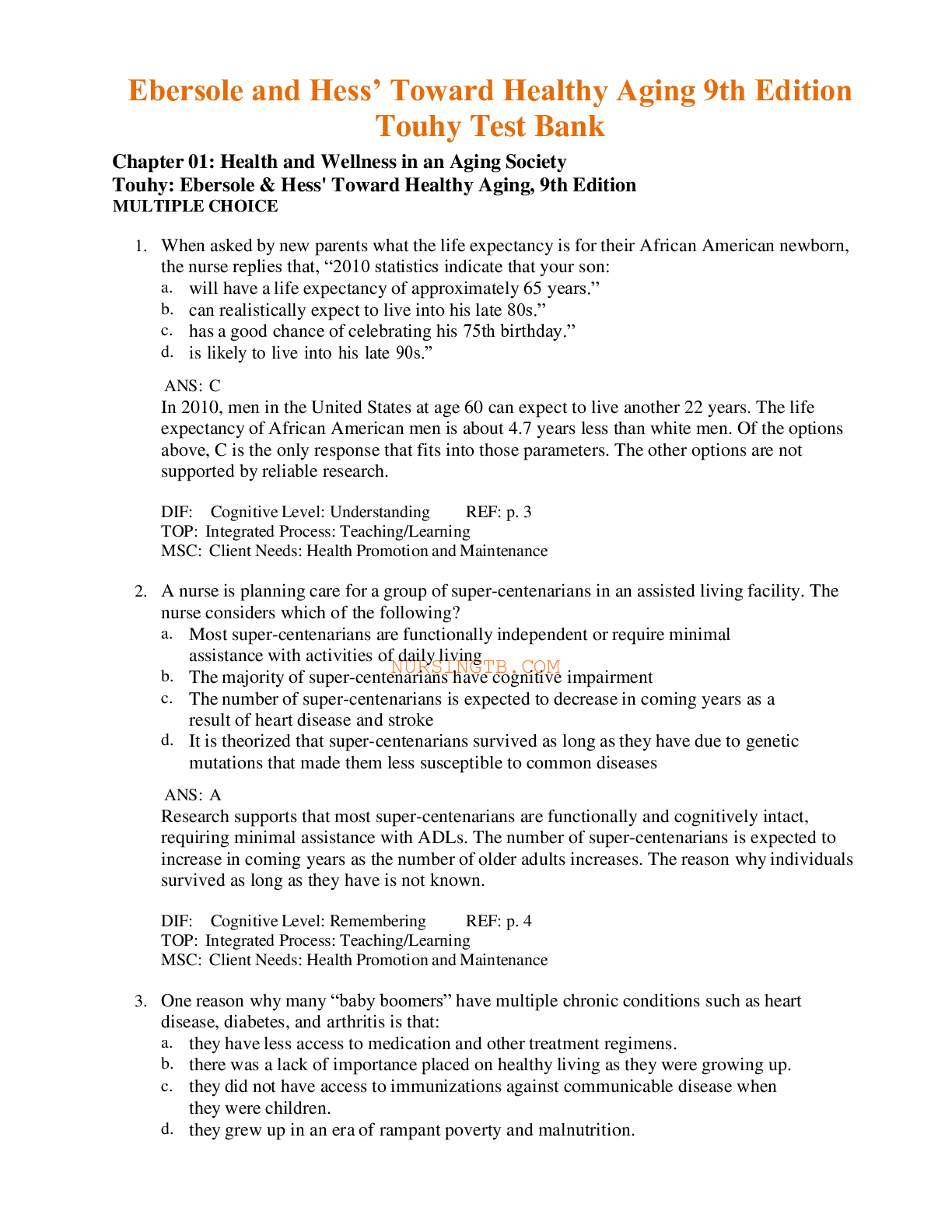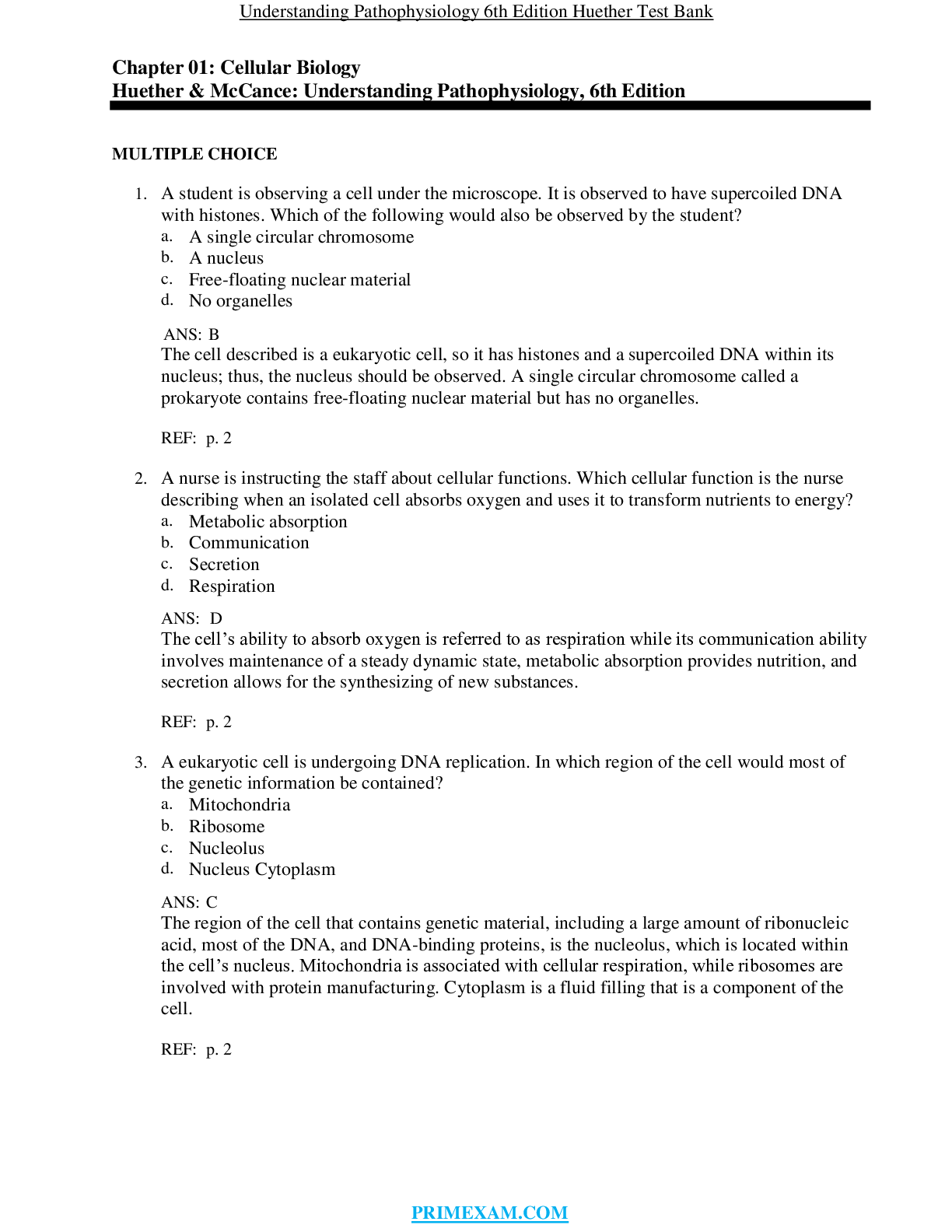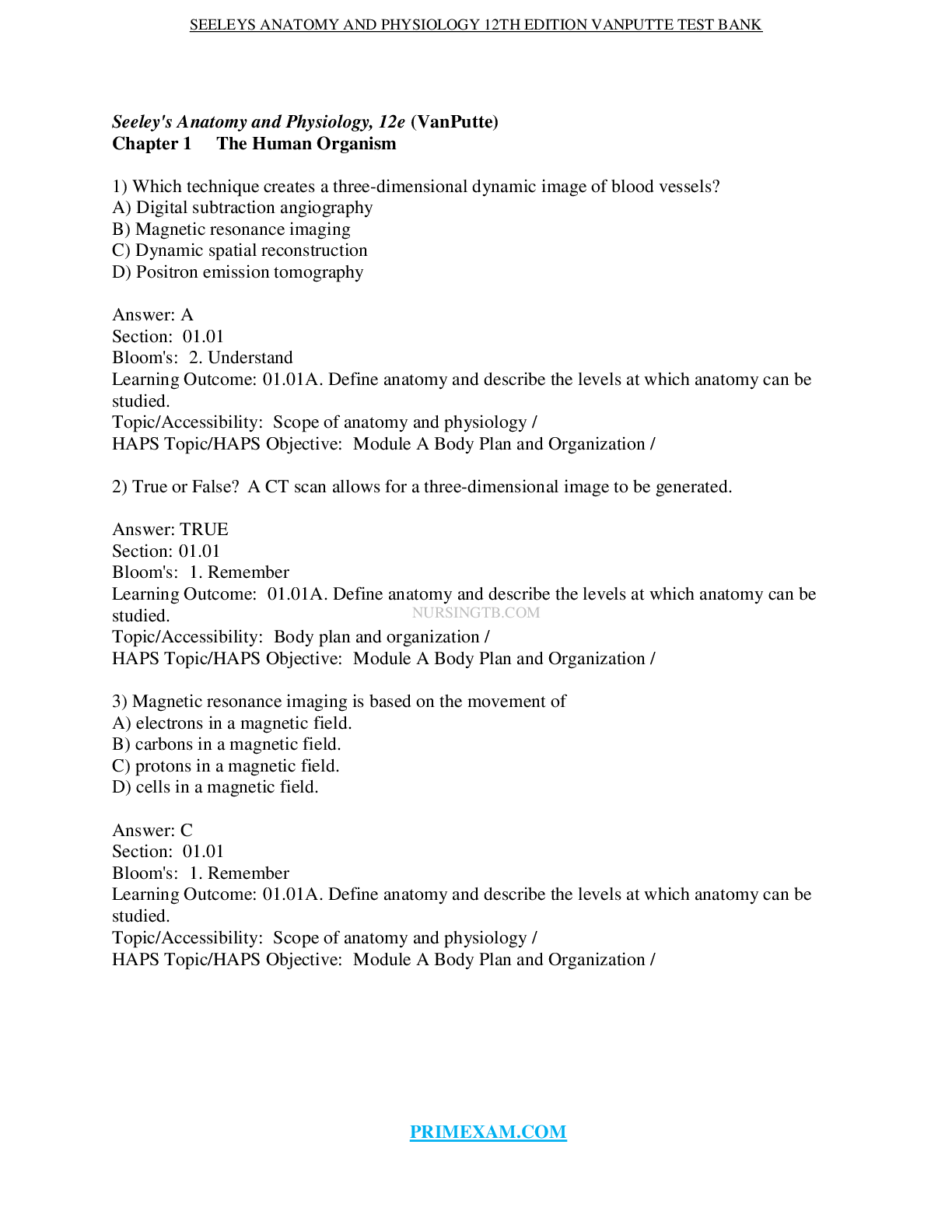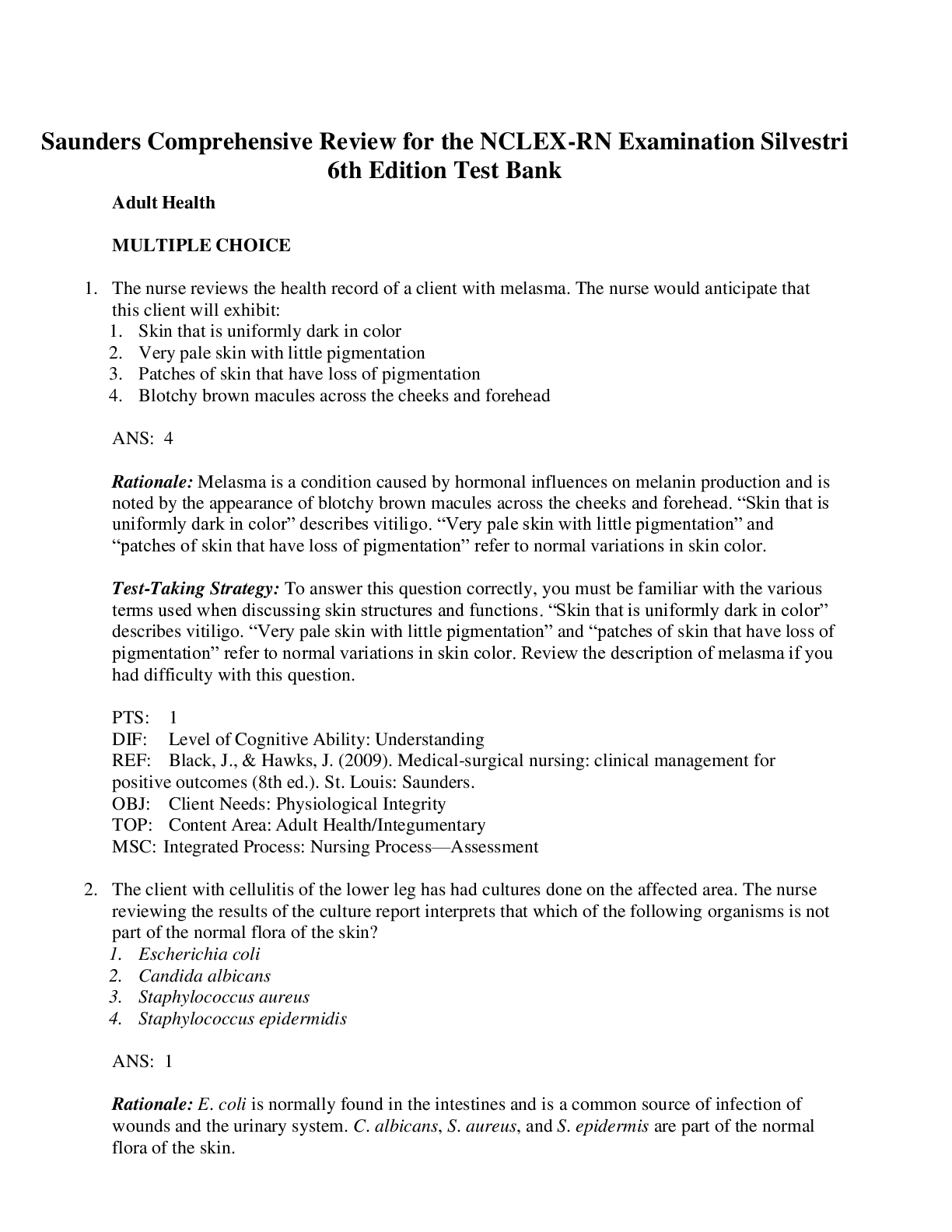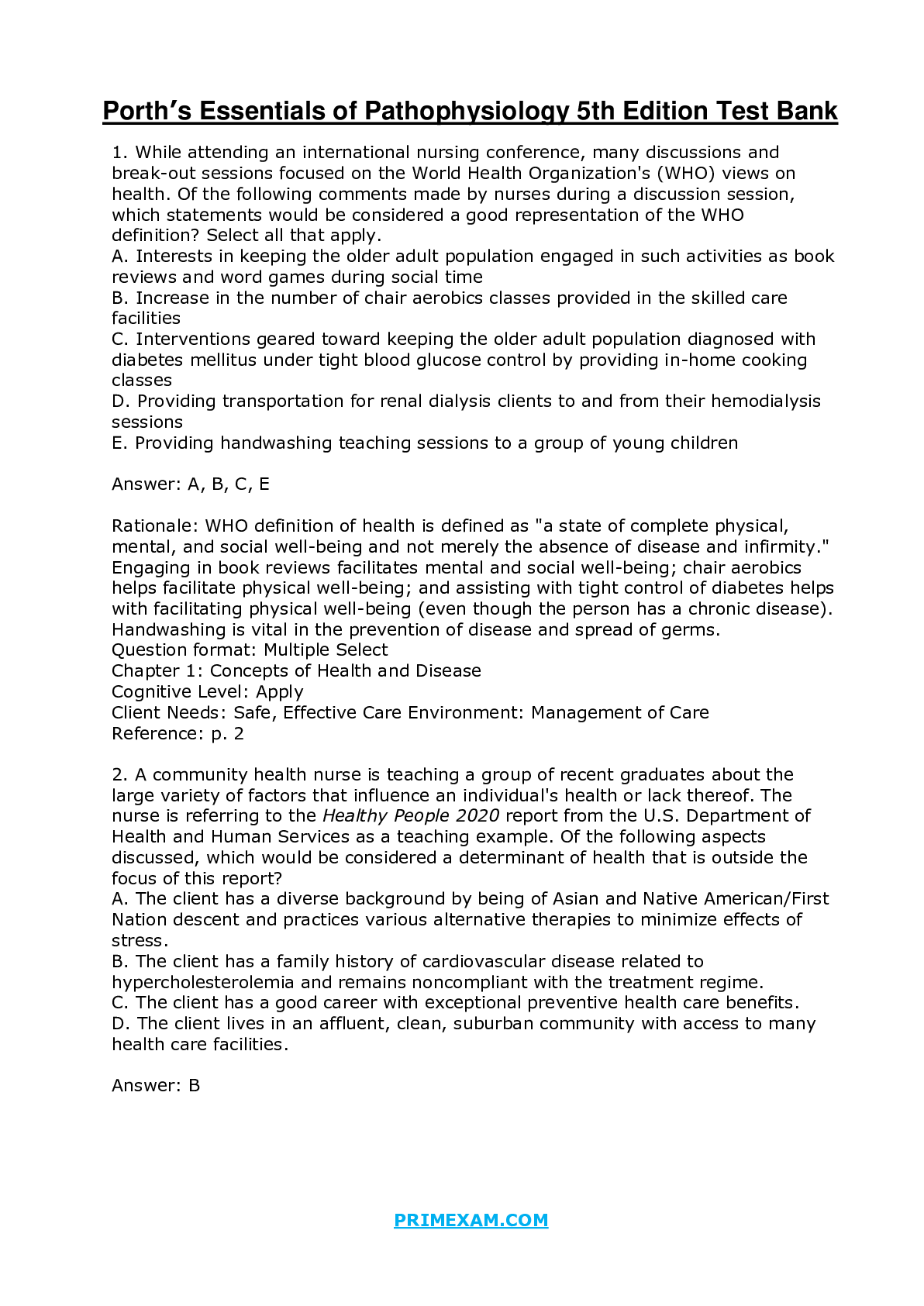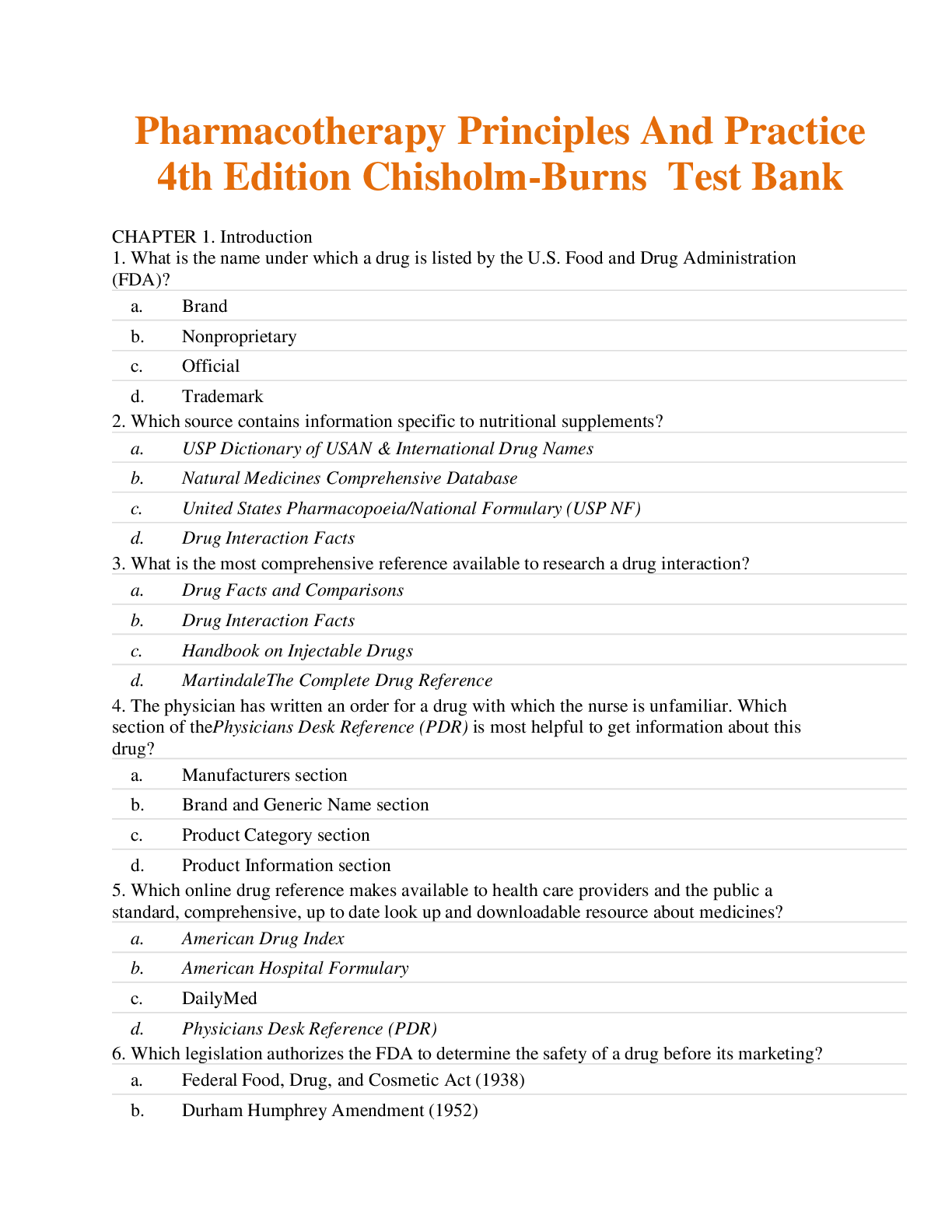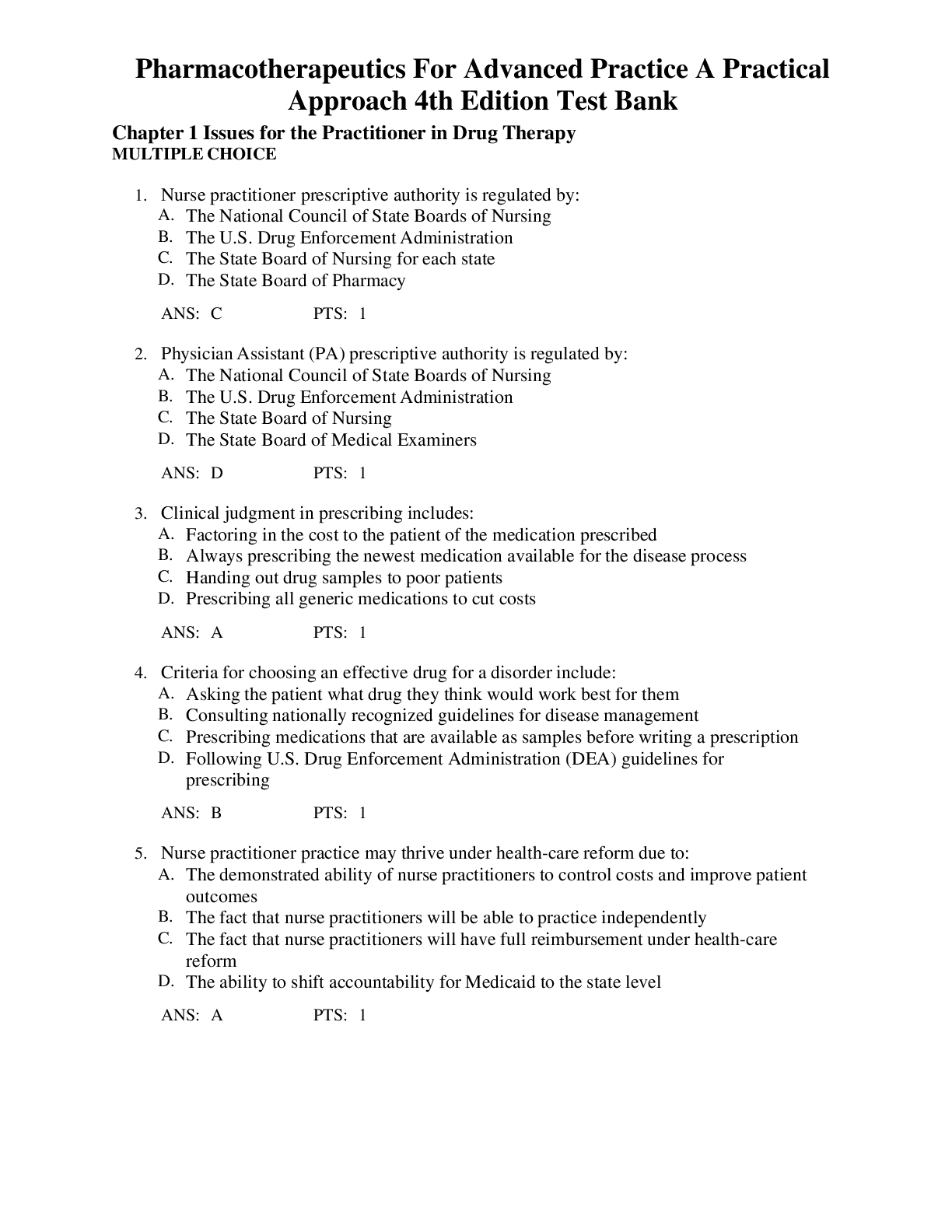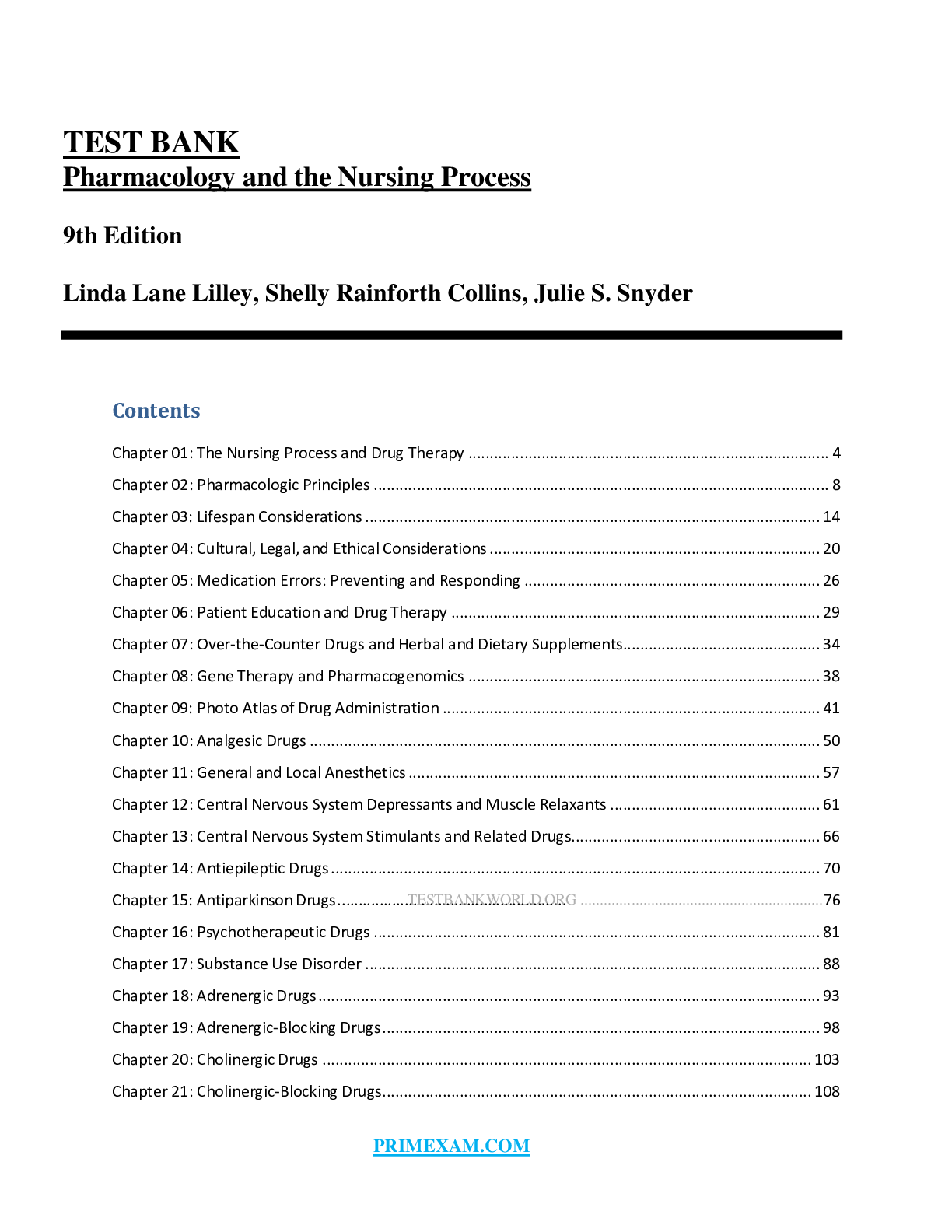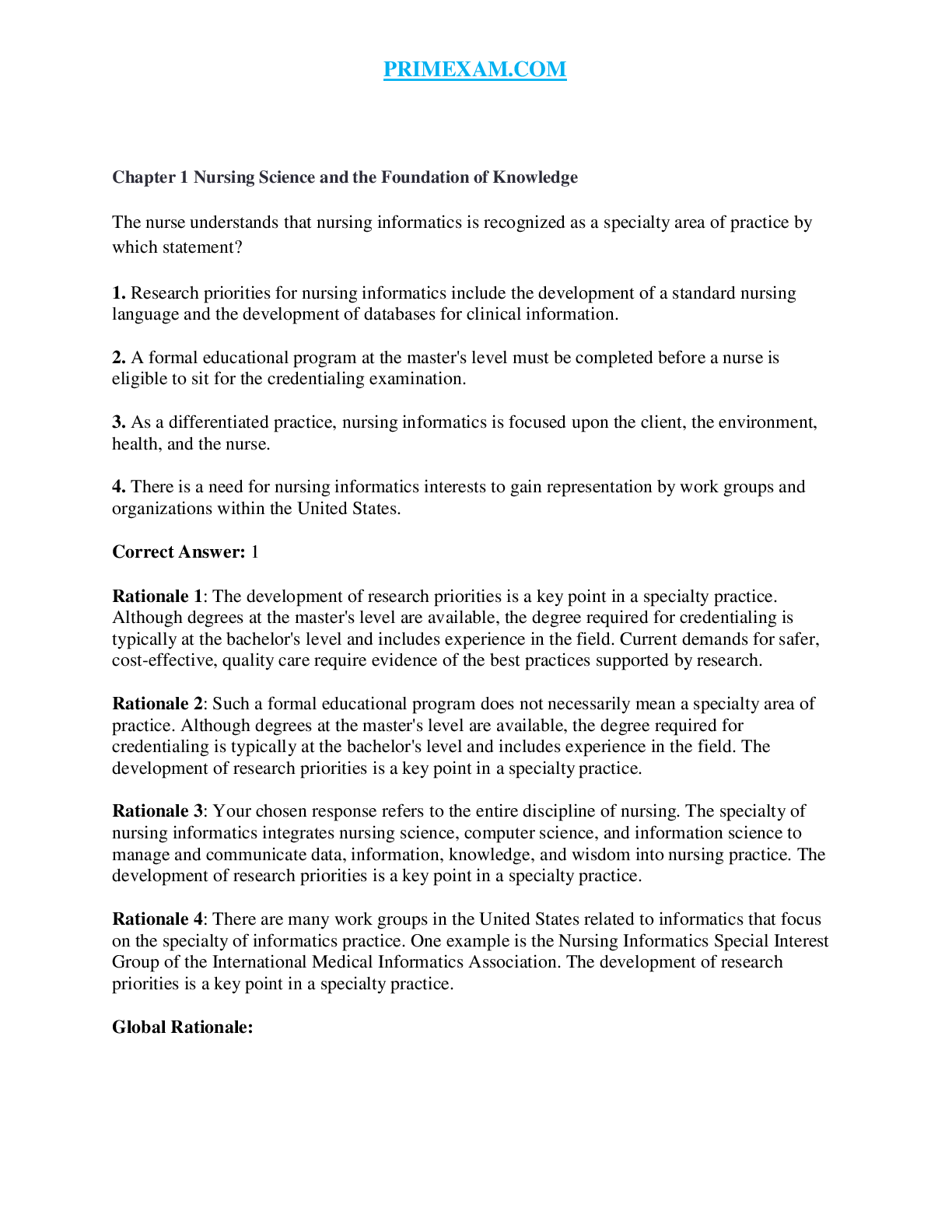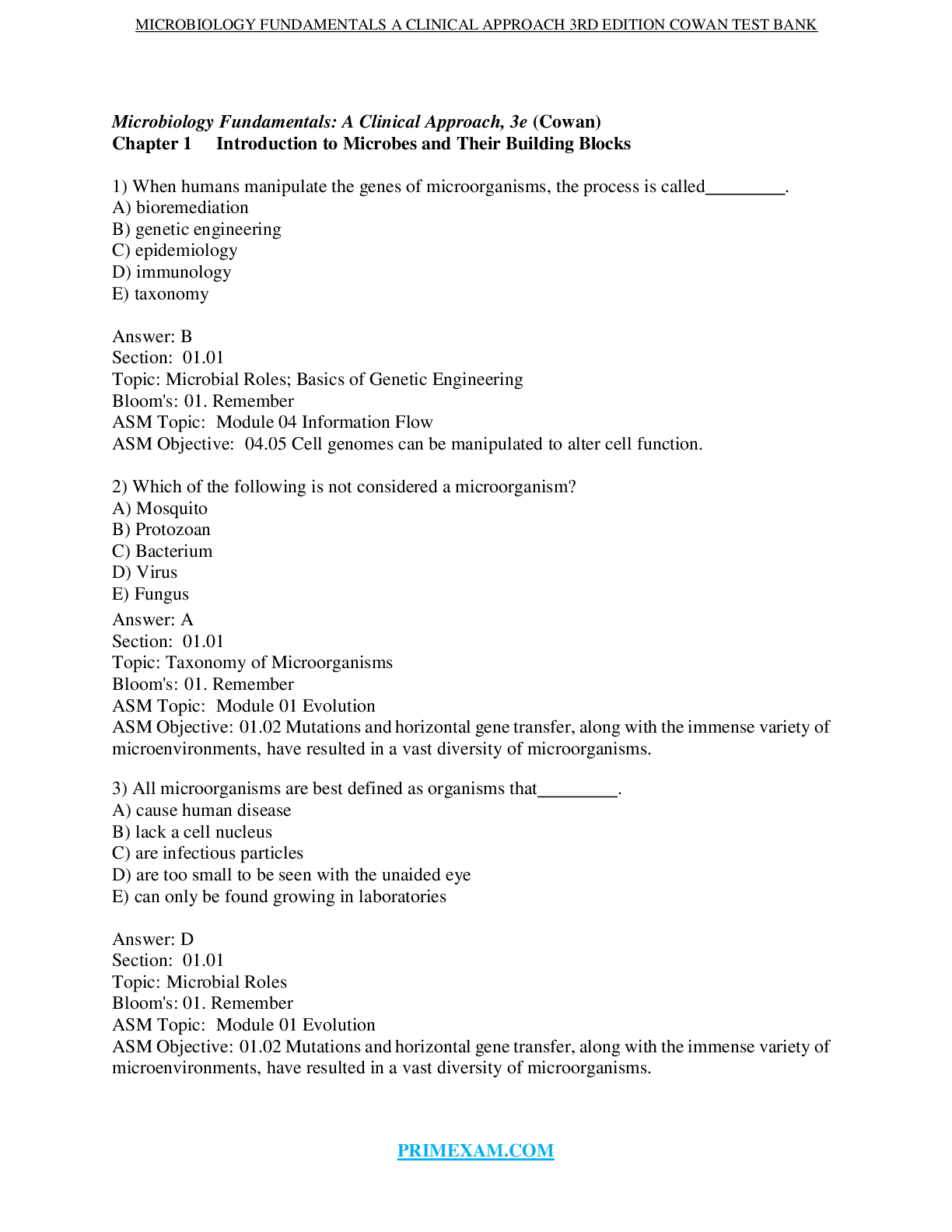*NURSING > TEST BANK > TOUHY EBERSOLE AND HESS' TOWARD HEALTHY AGING 9TH EDITION TEST BANK | LATEST UPDATE 2022 (All)
TOUHY EBERSOLE AND HESS' TOWARD HEALTHY AGING 9TH EDITION TEST BANK | LATEST UPDATE 2022
Document Content and Description Below
TOUHY EBERSOLE AND HESS' TOWARD HEALTHY AGING 9TH EDITION 2022 UPDATE TESTBANK TOUHY EBERSOLE AND HESS' TOWARD HEALTHY AGING 9TH EDITION 2022 UPDATE TESTBANK Ebersole & Hess TOUHY EBERSOLE AND HES... S' TOWARD HEALTHY AGING 9TH EDITION Chapter 01: Health and Wellness in an Aging Society Touhy: Ebersole & Hess' Toward Healthy Aging, 9th Edition MULTIPLE CHOICE 1. When asked by new parents what the life expectancy is for their African American newborn, the nurse replies that, “2010 statistics indicate that your son: a. will have a life expectancy of approximately 65 years.” b. can realistically expect to live into his late 80s.” c. has a good chance of celebrating his 75th birthday.” d. is likely to live into his late 90s.” ANS: C In 2010, men in the United States at age 60 can expect to live another 22 years. The life expectancy of African American men is about 4.7 years less than white men. Of the options above, C is the only response that fits into those parameters. The other options are not supported by reliable research. DIF: Cognitive Level: Understanding REF: p. 3 TOP: Integrated Process: Teaching/Learning MSC: Client Needs: Health Promotion and Maintenance 2. A nurse is planning care for a group of super-centenarians in an assisted living facility. The nurse considers which of the following? a. Most super-centenarians are functionally independent or require minimal assistance with activities of daily living b. The majority of super-centenarians have cognitive impairment c. The number of super-centenarians is expected to decrease in coming years as a result of heart disease and stroke d. It is theorized that super-centenarians survived as long as they have due to genetic mutations that made them less susceptible to common diseases ANS: A Research supports that most super-centenarians are functionally and cognitively intact, requiring minimal assistance with ADLs. The number of super-centenarians is expected to increase in coming years as the number of older adults increases. The reason why individuals survived as long as they have is not known. DIF: Cognitive Level: Remembering REF: p. 4 TOP: Integrated Process: Teaching/Learning MSC: Client Needs: Health Promotion and Maintenance 3. One reason why many “baby boomers” have multiple chronic conditions such as heart disease, diabetes, and arthritis is that: a. they have less access to medication and other treatment regimens. b. there was a lack of importance placed on healthy living as they were growing up. c. they did not have access to immunizations against communicable disease when they were children. d. they grew up in an era of rampant poverty and malnutrition. ANS: B The baby boomers, individuals born between 1946 and 1964, post-WWII, have better access to medication and treatment regimens than other cohorts. They have had the benefit of the development of immunizations against communicable diseases. They grew up in an era of prosperity post-WWII. However, there was a lack of importance placed on what we now consider healthy living when they were younger. Smoking, for example, was not condoned, but was considered a symbol of status. Candy in the shape of cigarettes was popular, and there was much secondhand smoke. DIF: Cognitive Level: Remembering REF: p. 6 TOP: Integrated Process: Teaching/Learning MSC: Client Needs: Health Promotion and Maintenance 4. A nurse is planning an education program on wellness in a local senior citizen center. The nurse plans to provide education on the importance of immunizations, annual physical examinations, screening for diabetes, and vision and hearing screening. It is important for the nurse to understand which of the following? a. Approximately 40% of older adults (ages 65 and older) utilize available preventive services b. Preventive strategies are more widely used in the 40-64 age group than in the 65 and over age group c. The research on health promotion strategies in older adults demonstrates that they have low efficacy d. There is an abundance of research specific to health promotion and aging ANS: A Approximately 40% of individuals, ages 65 and older, utilize the preventive services that are available to them. However, only 24% of those between the ages of 40 and 64 do so. There is a paucity of research specific to health promotion and aging; however, the research that exists demonstrates that health promotion strategies are highly effective. DIF: Cognitive Level: Understanding REF: p. 7 TOP: Integrated Process: Teaching/Learning MSC: Client Needs: Health Promotion and Maintenance 5. A nurse is caring for an 85-year-old male client with diabetes in a community setting. The nurse promotes functional wellness by which of the following activities? a. Encouraging the client maintains current levels of physical activity b. Assisting the client to receive all the recommended preventive screenings that are appropriate for his age group c. Teaching the patient how to use a rolling walker so that he can ambulate for longer distances d. Encouraging the client to attend his weekly chess games ANS: A Maintaining existing levels of physical activity is consistent with functional wellness. Teaching the client how to use a rolling walker enables the client to remain active at the highest level possible, which is an example of promoting functional wellness. Receiving recommended screening is an example of promoting biological wellness. The use of a rolling walker should be based on assessment of physical ability. Encouraging the client to attend weekly chess games is an example of promoting social wellness. DIF: Cognitive Level: Applying REF: p. 10 TOP: Integrated Process: Teaching/Learning MSC: Client Needs: Health Promotion and Maintenance 6. Based on the census reports of 2010, the typical profile of a centenarian in the United States includes which of the following characteristics? a. A Caucasian woman who lives in an urban area of a Southern state b. An African American woman who lives in a rural area of a Southern state c. A Hispanic man who lives in an urban area of a Midwestern state d. A Caucasian man who lives in a rural area of a Midwestern state ANS: A Based on the 2010 U.S. Census data, centenarians were overwhelmingly white (82.5%), women (82.8%), and living in urban areas of the Southern states. DIF: Cognitive Level: Applying REF: p. 5 TOP: Integrated Process: Teaching/Learning MSC: Client Needs: Health Promotion and Maintenance MULTIPLE RESPONSE 1. Primary prevention strategies for older adults include which of the following? (Select all that apply.) a. An annual influenza immunization clinic b. A smoking cessation program c. A prostate screening program d. A cardiac rehabilitation program e. A meal planning education program for type 2 diabetics ANS: A, B Primary prevention refers to strategies that are used to prevent an illness before it occurs and maintaining wellness across the continuum of care. Immunizations and smoking cessation are examples of primary prevention. Secondary prevention is the early detection of a disease or a health problem that has already developed. Prostate screening is an example of secondary prevention. Tertiary prevention addresses the needs of individuals who already have their wellness challenged. Cardiac rehabilitation and meal planning for diabetics are examples of tertiary prevention. DIF: Cognitive Level: Applying REF: pp. 8–9 TOP: Integrated Process: Teaching/Learning MSC: Client Needs: Management of Care 2. A nurse organizes a health fair for older adults. The nurse’s goal is to focus on the six priority areas identified by the National Prevention Council. Which of the following activities should the nurse include? (Select all that apply.) a. Smoking cessation b. Depression screening c. Recognizing elder abuse d. Cholesterol screening e. Fitness training ANS: A, B, C The six priority areas of the National Prevention Council include tobacco-free living, preventing drug abuse and excessive alcohol use, healthy eating, injury- and violence-free living, reproductive and sexual health, and mental and emotional well-being. Smoking cessation, depression screening, and recognizing elder abuse all directly address these areas. While cholesterol screening and fitness training are important for older adults, they do not address these six priority areas. DIF: Cognitive Level: Analyzing REF: p. 8 TOP: Integrated Process: Teaching/Learning MSC: Client Needs: Health Promotion and Maintenance 3. The “in-between” generation (individuals born between 1915 and 1945) were subject to which of the following health challenges during their childhood? (Select all that apply.) a. Polio b. Lack of fluoride in the water causing teeth to be soft and cavity prone c. “Pigeon Chest,” a malformation of the rib cage due to a lack of vitamin D d. Smallpox e. HIV/AIDS ANS: A, B, C Polio was a major fear of this group; the polio vaccine was not available in the United States until 1955. In many areas water was not fluoridated. “Pigeon Chest” was common. Smallpox was a concern for the centenarians, not this generation. HIV/AIDS had not been identified in the early years of 1915-1945. DIF: Cognitive Level: Remembering REF: p. 5 TOP: Integrated Process: Teaching/Learning MSC: Client Needs: Health Promotion and Maintenance 4. A nursing student is preparing a presentation on the Wellness-Based Model for Healthy Aging. Which of the following concepts should the student include in the presentation? (Select all that apply.) a. Healthy aging is defined by the absence of physical illness alone b. Healthy aging is individually defined and can change over time c. There are many strategies to promote healthy aging that are believed to be helpful but do not have empirical evidence to support them d. Healthy aging cannot be achieved by only focusing on later life. It is a lifelong process e. According to this model, an individual with a chronic disease would not be considered healthy ANS: B, C, D Healthy aging is a lifelong process that begins with birth and ends with death. The concept of healthy aging from a wellness perspective is uniquely defined by each individual and can change over time. There are challenges to implementing evidence-based practices on healthy aging because there is a paucity of research on this area. Therefore, there are many strategies that have been used and determined to be effective but do not have research evidence supporting them. The subcomponents with the wellness model are functional independence, self-care management of illness, personal growth, positive outlook, and social contribution and activities that promote one’s health. DIF: Cognitive Level: Applying REF: p. 7 TOP: Integrated Process: Teaching/Learning MSC: Client Needs: Health Promotion and Maintenance Chapter 02: Gerontological Nursing: Past, Present, and Future Touhy: Ebersole & Hess' Toward Healthy Aging, 9th Edition MULTIPLE CHOICE 1. Serious and well-controlled research studies on aging have been available: a. only in the past 60 years. b. since the turn of the 20th century. c. following the Great Depression. d. since the year 2000. ANS: A Only in the past 60 years have serious and carefully controlled research studies flourished. Before that, anecdotal evidence was used to illustrate issues assumed to be universal, making all the remaining options incorrect. DIF: Cognitive Level: Remembering REF: p. 19 TOP: Integrated Process: Teaching/Learning MSC: Client Needs: Health Promotion and Maintenance 2. The son of a nursing home resident asks a nurse: “What is the significance of being certified in gerontology? I see that you are, but not all of the nurses are.” The best response by the nurse is which of the following? a. “National certification as a gerontological nurse is a way to demonstrate special knowledge in caring for older adults” b. “National certification in gerontology is required for all nurses who have worked in this setting for 2 or more years” c. “National certification is only available to nurses who have a Baccalaureate degree in nursing” d. “Only advanced practice nurses, like nurse practitioners, are certified in gerontology” ANS: A National certification is a way to demonstrate special expertise in caring for older adults. It is not required for practice in any setting across the continuum of care, and it is not exclusive to nurses with Baccalaureate degrees. There is both a generalist and a specialist gerontological nursing certification. The generalist functions in a variety of settings providing care to older adults and their families. The specialist has advanced gerontological education at a Masters level. DIF: Cognitive Level: Analyzing REF: pp. 20–21 TOP: Integrated Process: Communication and Documentation MSC: Client Needs: Management of Care 3. The major goal of the NICHE (Nurses Improving Care for Health System Elders) program includes which of the following? a. Improve outcomes for hospitalized older adults b. Increase the number of older adults cared for in hospitals c. Increase the number of iatrogenic complications that occur in hospitalized older adults d. Decrease 30-day readmission rates for hospitalized older adults ANS: A The goal of NICHE is to improve outcomes for hospitalized older adults. Although D is a good outcome for hospitalized older adults, it is not one of the major goals of NICHE, which are broader. Options b and c are not goals that would improve care for older adults, but would be negative outcomes themselves. DIF: Cognitive Level: Remembering REF: p. 22 TOP: Integrated Process: Teaching/Learning MSC: Client Needs: Health Promotion and Maintenance MULTIPLE RESPONSE 1. The impact of the Patient Protection and Affordable Care Act of 2010 on gerontological nursing includes which of the following? (Select all that apply.) a. Funding to support advanced education in gerontological nursing b. Funding to support education of faculty in gerontology c. Funding to increase the number of direct care workers in hospitals d. Funding to increase nurse-patient ratios in long-term care e. Funding for advanced training of direct care workers in long-term care ANS: A, B, E The Patient Protection and Affordable Care Act of 2010 provides funding for advanced education in gerontology, education for faculty in gerontology, and advanced training for direct care workers in long-term care. The act does not address nurse-patient ratios or staffing issues in any setting. DIF: Cognitive Level: Understanding REF: p. 14 TOP: Integrated Process: Teaching/Learning MSC: Client Needs: Health Promotion and Maintenance 2. Which of the following are true statements about the current health care workforce? (Select all that apply.) a. Approximately 10% of registered nurses (RNs) are certified in gerontological nursing b. The number of geriatricians is expected to increase about 50% over the next 25 years c. The professions of social work, physical therapy, and psychiatry are demonstrating the same trends as nursing d. Europe and the developing countries are experiencing similar shortages in health care workers with geriatric expertise as in the United States e. It is anticipated that there will be a need for approximately 3 million additional direct care and professional health care workers by the year 2030 ANS: C, D, E Less than 1% of RNs are certified in gerontological nursing. The number of geriatricians is decreasing, not increasing. Responses C, D, and E are all true. DIF: Cognitive Level: Understanding REF: p. 14 TOP: Integrated Process: Teaching/Learning MSC: Client Needs: Health Promotion and Maintenance 3. Best practice recommendations for undergraduate nursing education in relation to gerontology include which of the following? (Select all that apply.) a. Provision of a “stand-alone” course in gerontological nursing b. Integration of gerontological content throughout the curriculum c. Replacement of acute care pediatric clinical experiences with gerontological clinical experiences d. Recruitment of nurses with Masters and Doctoral degrees and a specialty in gerontology to faculty roles e. Requiring all undergraduate nursing students to obtain gerontological certification as a requirement for graduation ANS: A, B, D Best practices include providing a stand-alone gerontological nursing course as well as integrating gerontology throughout the curriculum. Recruitment of nurses with a specialty in gerontology and a Masters or Doctoral degree to faculty roles is a critical step in making sure that the next generation of nurses is prepared to care for older adults. Best practices do not recommend removing pediatric clinical experiences and replacing them with gerontological experiences. Nursing certification is only available to practicing nurses who meet specific education and practice requirements. It is not applicable to nursing students. DIF: Cognitive Level: Understanding REF: pp. 17–18 TOP: Integrated Process: Teaching/Learning MSC: Client Needs: Health Promotion and Maintenance 4. Goals of the Eldercare Workforce Alliance include which of the following? (Select all that apply.) a. Mandating a minimum of a Baccalaureate degree in nursing in order to care for older adults b. Increasing wages of certified nursing assistants (CNAs) in nursing homes c. Providing loan forgiveness for individuals who assume faculty roles d. Developing a nursing certification specific to long-term care e. Adopting cost-effective care coordination models for older adults across the continuum of care ANS: B, C, E A, B, and C are all included in the Elder Workforce Alliance goals. Options A and D are not. DIF: Cognitive Level: Understanding REF: p. 14 TOP: Integrated Process: Teaching/Learning MSC: Client Needs: Health Promotion and Maintenance 5. A nurse interviews for a job in a hospital that advertises that it is “elderly friendly.” The nurse would expect to see which of the following in place? (Select all that apply.) a. An elder-assistance program to help patients remember their appointments and navigate the hospital services. b. A long-term care facility that is affiliated with the hospital c. Rooms furnished with foldout beds for family members/caregivers d. An initiative to provide gerontological education for all nurses e. An initiative to increase the number of patients referred to long-term care facilities upon discharge from the hospital ANS: A, C, D The guiding principles of an elder friendly facility include treating each patient as a unique individual and accommodating the patient and family’s special needs. Other principles include ensuring that the nurses are clinically competent in gerontological nursing. Tailoring the environment to support the implementation of these principles is part of this initiative. Option B is not correct as it does not relate to the concept of an elder friendly hospital. Option E is not correct since this might not be a supportive intervention for all patients. DIF: Cognitive Level: Analyzing REF: p. 22, Box 2-7 TOP: Integrated Process: Caring MSC: Client Needs: Psychosocial Integrity 6. Significant factors contributing to the growth of community-based care include: (Select all that apply.) a. a decrease in the number of available nursing home beds. b. rapidly escalating health care costs. c. older adults’ preferences to “age in place.” d. inadequate numbers of nurses with gerontological specialty education. e. decreasing numbers of family caregivers. ANS: B, C Care will continue to move out of hospitals and long-term care facilities because of rapidly escalating health care costs and individual preferences to “age in place.” There has not been a decrease in nursing home beds. Although there are inadequate numbers of nurses with gerontological specialty training, this is not a factor that has impacted the growth of community-based care. There is projected to be a decrease in the number of family caregivers as the caregivers themselves are aging; however, this does not contribute to the growth of community-based care. DIF: Cognitive Level: Remembering REF: p. 23 TOP: Integrated Process: Teaching/Learning MSC: Client Needs: Health Promotion and Maintenance 7. Changes in certified nursing facilities in recent years include which of the following? (Select all that apply.) a. Increase in the number of subacute beds b. Decrease in nursing facility length of stay c. Increase in level of acuity of the residents d. Decrease in cost of care in the nursing facility e. Decrease in the number of registered nurses employed in long-term care facilities ANS: A, B, C Certified nursing facilities have evolved over recent years. Most facilities have subacute care units that resemble hospital units caring for more patients with higher acuity than in the past. Therefore, the average length of stay in a facility has decreased. The cost of care in the facility has increased due to the increased complexity of illnesses treated, and the number of registered nurses has increased in order to care for these complex patients. DIF: Cognitive Level: Analyzing REF: p. 23 TOP: Integrated Process: Teaching/Learning MSC: Client Needs: Health Promotion and Maintenance 8. Which of the following factors contribute to poor outcomes for older adults during transitions of care? (Select all that apply.) a. Inability to read and understand discharge instructions b. Inadequate financial resources to purchase medications c. Lack of desire to comply with discharge instructions d. Improved medication reconciliation during hospitalization e. High levels of nurse-patient engagement ANS: A, B Language and literacy levels and socioeconomic factors are major contributors to poor transitions of care for older adults. A high level of nurse-patient engagement contributes to safe and effective transitions. Medication reconciliation during hospitalization, at discharge and after discharge, decreases medication discrepancies, which are the most prevalent adverse event following hospital discharge. There is no evidence that patients lack the desire to comply with discharge instructions. DIF: Cognitive Level: Analyzing REF: p. 24 TOP: Integrated Process: Communication and Documentation MSC: Client Needs: Safety and Infection Control Chapter 04: Cross-Cultural Caring and Aging Touhy: Ebersole & Hess' Toward Healthy Aging, 9th Edition MULTIPLE CHOICE 1. A paper on culture and illness would be likely to include the statement that: a. culture is the same as ethnicity. b. ethnic groups always share common geographic origin and religion. c. ethnicity involves recognized traditions, symbols, and literature. d. most members of an ethnic group exhibit identical cultural traits. ANS: C Ethnicity is a complex phenomenon including traditions, symbols, literature, folklore, food preferences, and dress. It is a shared identity. Ethnicity is more than just culture. It is social differentiation based on culture. Even within ethnic groups, there is considerable diversity. DIF: Cognitive Level: Remembering REF: p. 44 TOP: Integrated Process: Teaching/Learning MSC: Client Needs: Psychosocial Integrity 2. Ethnocentrism is defined as: a. an understanding of another’s cultural beliefs and practices. b. a conflict that occurs when an individual interacts with another whose beliefs differ from his own. c. application of limited knowledge about one person with characteristics specific to another person. d. a belief that one’s ethnic group is superior to that of another. ANS: D A belief that one’s ethnic group is superior to that of another is the definition of ethnocentrism. Ethnocentrism does not involve an understanding of the beliefs of others. A conflict that occurs when an individual interacts with another whose beliefs differ from his own is the definition of cultural conflict. Application of limited knowledge about one person with characteristics specific to another person is the definition of stereotyping. DIF: Cognitive Level: Remembering REF: p. 42 TOP: Integrated Process: Teaching/Learning MSC: Client Needs: Psychosocial Integrity 3. Regarding health care disparities, it is true that older adults of color have: a. equal risk factors for vulnerability as do all older adults. b. equal risk factors for vulnerability as do the young adults of color. c. increased risk factors for vulnerability if they are female. d. an increase in risk factors for vulnerability if care is provided by public facilities. ANS: C Older females of color have an added risk factor for vulnerability (gender) than do males of the same age and ethnic group. Ethnicity is an added factor for vulnerability. Age is an additional risk factor for vulnerability. Health care disparities are found across a wide range of clinical settings. DIF: Cognitive Level: Remembering REF: p. 41 TOP: Integrated Process: Teaching/Learning MSC: Client Needs: Psychosocial Integrity 4. An older female patient tells a nurse the following: “In my culture, women are the silent partner in the family. Men make all of the decisions. However, when we came to the United States, all that changed. I became an American. I am in charge of my family just like my husband.” This is an example of: a. enculturation. b. acculturation. c. ethnicity. d. culture competence. ANS: B Enculturation is defined as cultural beliefs passed down from one generation to the next. Acculturation is the process by which persons from one culture adapt to another. Ethnicity is defined as the cultural group that one identifies with. Cultural competence involves stepping outside our own biases and understanding that others bring a different set of values. DIF: Cognitive Level: Applying REF: p. 40 TOP: Integrated Process: Teaching/Learning MSC: Client Needs: Psychosocial Integrity 5. A home care nurse is caring for an older patient from a different culture who is bed-bound and high risk for development of a pressure ulcer. The nurse discusses the plan of care with the patient’s daughter, emphasizing the importance of turning every 2 hours and posts a turning clock on the wall. When the nurse returns later in the week, the turning clock has been removed, and the patient’s daughter reports that she turns her mother occasionally. She states, “I am taking very good care of my mother. You just don’t understand; our ways do not involve doing things on schedules.” The best response by the nurse is: a. “You must follow my guidelines and turn her every 2 hours, or I will not be able to take care of her.” b. “I understand that you value your culture, but culture cannot stop you from providing good care to your mother.” c. “I understand that you care very much for your mother. Perhaps caring for her is too much for you.” d. “How can we best work together to provide the best care for your mother?” ANS: D In providing cross-cultural care it is important that the nurse work with the patient and family and listen carefully and find a way to include the values and beliefs of the patient in the plan of care. DIF: Cognitive Level: Analyzing REF: p. 43 TOP: Integrated Process: Communication and Documentation MSC: Client Needs: Psychosocial Integrity 6. An older patient learns that he has metastatic cancer. The patient states: “I must have angered God.” This is an example of which type of belief? a. Biomedical b. Magico-religious c. Naturalistic d. Ayurvedic ANS: B Magico-religious: views illness as caused by actions of a higher authority. Biomedical: views disease as a result of abnormalities in structure and function and disease caused by intrusion of pathogens into the body. Naturalistic: based on the concepts of balance. Health is seen as a sign of balance. Ayurvedic: the oldest known paradigm in the naturalistic system. Illness is seen as an imbalance. DIF: Cognitive Level: Remembering REF: p. 46 TOP: Integrated Process: Communication and Documentation MSC: Client Needs: Psychosocial Integrity 7. A female nurse is caring for an older woman from the Hasidic Jewish community. The woman’s son is at the patient’s bedside. The nurse notes that when she communicates with the patient and her son, the son does not maintain eye contact with her and also notes that he withdraws when she attempts to shake his hand. The best response by the nurse is to: a. carry on conversation with the patient only, ignoring the son. b. continue conversing with both the patient and the son. c. ask the son to leave since he is not comfortable with her. d. ask the patient why the son will not engage with her. ANS: B In some cultures, direct eye contact or contact between men and women is seen as a sexual advance. This is true in the Hasidic culture. Options A and C are disrespectful to the patient and her son. Option D may put the son in an uncomfortable position. DIF: Cognitive Level: Analyzing REF: p. 48 TOP: Integrated Process: Communication and Documentation MSC: Client Needs: Psychosocial Integrity MULTIPLE RESPONSE 1. The nurse in a clinic setting that provides care for an ethnically diverse population of older clients shows an understanding of the LEARN Model to direct the assessment process when: (Select all that apply.) a. recognizing that the client’s hands are clenched as she answers the assessment questions. b. asking the client to describe what he thinks will help him feel better. c. explaining to the client that herbal remedies may not be sufficient treatment for his chest congestion. d. acknowledging that the client has a different view of the appropriate treatment. e. suggesting to the client that it would be beneficial if she would trust her health care provider to prescribe the correct treatment. ANS: A, B, C, D The LEARN Model implements active listening to both the client’s verbal and nonverbal communication as a means of obtaining insight into the client’s perspective of his or her medical problem. This model also encourages the nurse to recognize that the perceptions may differ and to explain the differences in perceptions to the client. The model advocates arriving at a mutually agreed upon treatment plan rather than encouraging the client to surrender personal autonomy in the decision-making. DIF: Cognitive Level: Remembering REF: p. 50 TOP: Integrated Process: Teaching/Learning MSC: Client Needs: Psychosocial Integrity 2. A nurse completes a cultural assessment of an older adult who is being admitted to an assisted living facility. Reasons for completing a cultural assessment include: (Select all that apply.) a. culture guides decision-making about health, illness, and preventive care. b. culture provides direction for individuals on how to interact during health care encounters. c. culture impacts attitudes toward aging. d. all members of a culture react in the same way in similar situations. e. knowledge of culture eliminates health care disparities. ANS: A, B, C Although knowledge of culture has the potential to optimize care, not all individuals will respond in the same way to a specific situation. Knowledge of an individual’s culture will not eliminate health care disparities. DIF: Cognitive Level: Understanding REF: pp. 49–50 TOP: Integrated Process: Teaching/Learning MSC: Client Needs: Psychosocial Integrity 3. A nurse in the ambulatory care setting is preparing to do an interview with a non-English-speaking client. The nurse secures an interpreter. In order to have the most effective interview, the nurse should do which of the following? (Select all that apply.) a. Look and speak to the interpreter b. Use technical terminology to ensure accuracy c. Allow more time for the interview d. Watch the client’s nonverbal communication e. Have the interpreter check whether the client understands the communication ANS: C, D For the most effective interview the nurse should look and speak directly to the client, avoid the use of jargon and technical terminology, observe the client’s nonverbal communications, and clarify understanding by asking the client to state in his/her own words what he or she understood, facilitated by the interpreter. The interview will take longer. DIF: Cognitive Level: Remembering REF: p. 48 TOP: Integrated Process: Communication and Documentation MSC: Client Needs: Psychosocial Integrity Chapter 05: Cognition and Learning Touhy: Ebersole & Hess' Toward Healthy Aging, 9th Edition MULTIPLE CHOICE 1. Health literacy is defined as: a. the capacity to read basic health information in order to make appropriate health decisions. b. the capacity to obtain, process, and understand basic health information needed to make appropriate health decisions. c. the capacity to read and write in order to access health care. d. the capacity to read and execute health care documents. ANS: B Health literacy involves more than basic reading and writing skills. It involves the ability to obtain, process, and understand health information in order to make health care decisions. DIF: Cognitive Level: Remembering REF: pp. 60–61 TOP: Integrated Process: Teaching/Learning MSC: Client Needs: Health Promotion and Maintenance 2. The daughter of an older hospitalized patient tells a nurse: “I am worried about my father. His memory is sharper when he is at home. He is forgetful, but is functional. Since he has been hospitalized his memory problems are much worse.” The best response by the nurse is: a. “It is common for long-term memory to be more impacted by age-related changes than short-term memory.” b. “Memory changes are often worse when an individual is in an unfamiliar or stressful situation.” c. “Perhaps you are just noticing your father’s memory loss now that he is hospitalized.” d. “There is a lot of new information for your father to process here in the hospital; he is overloaded.” ANS: B Memory changes are often worse when the individual is in unfamiliar or stressful situations, such as a hospitalization. Option A is not true, short-term memory is impacted more than long-term memory. Options C and D are true; however, they do not address the issue that the patient’s daughter is discussing. DIF: Cognitive Level: Analyzing REF: p. 56 TOP: Integrated Process: Teaching/Learning MSC: Client Needs: Health Promotion and Maintenance 3. An older resident in a senior community tells a nurse: “I am really worried. I joined an exercise class, and I just learned everyone’s name yesterday, and I cannot remember them all today. Am I developing Alzheimer’s disease?” The best response by the nurse is: a. “You should be concerned. It is very unusual to forget something that you just learned.” b. “There is no reason to be concerned. Short-term memory decreases with age.” c. “Don’t worry, a decline in both short- and long-term memory is a normal part of getting older.” d. “Although it is normal to have some changes in memory, forgetting names is very unusual.” ANS: B Even though some older adults show decrements in the ability to process information, the majority of functioning remains intact. Age-associated memory impairment is used to describe memory loss that is considered normal for one’s age and educational level. It may include slowness in processing, storing, and recalling new information and difficulty remembering names and words. DIF: Cognitive Level: Applying REF: p. 56 TOP: Integrated Process: Teaching/Learning MSC: Client Needs: Health Promotion and Maintenance MULTIPLE RESPONSE 1. A nurse is developing an educational session for a group of older adults at a senior center. Which of the following would the nurse include in the education? (Select all that apply.) a. Attention span, language, and communication skills typically remain stable with increasing age b. Older brains slow down and take longer to process constantly increasing amounts of information c. In order to preserve brain function, it is important to engage in challenging cognitive activities d. Older adults are not able to develop new cognitive abilities e. Individuals over age 100 have a higher prevalence of dementia than younger individuals ANS: A, B, C Older adulthood is no longer seen as a period when cognitive development is halted; it is a life stage where unique capacities are developed. Centenarians and super-centenarians have a lower prevalence of dementia then those under age 100. DIF: Cognitive Level: Remembering REF: p. 56 TOP: Integrated Process: Teaching/Learning MSC: Client Needs: Health Promotion and Maintenance 2. An older female resident of an assisted living facility says the following to a nurse: “I am very frightened about getting dementia. I have read a lot about brain exercises, but I am not sure what I should be doing.” The nurse formulates a response based on knowledge of which of the following? (Select all that apply.) a. Individuals should engage in some type of brain fitness activity a couple of times a week for at least 25 minutes b. Brain fitness activities are only effective if an individual has not experienced any memory problems at all c. Brain fitness activities may include computer-based games, memory training, board games, reading, and engaging in conversation d. Physical activity is important for wellness but is unrelated to brain fitness e. Individuals should choose brain exercise activities that are unfamiliar, challenging, and fun ANS: A, C, E Brain fitness activities are effective for individuals with normal memory or mild memory problems. Physical activity is important and has an impact on improving reaction time and working memory as well as posture, balance, and socialization. DIF: Cognitive Level: Applying REF: p. 57 TOP: Integrated Process: Teaching/Learning MSC: Client Needs: Health Promotion and Maintenance 3. A nurse is planning a fall prevention education refresher session for the residents of a long-term care facility. The individuals are all cognitively intact and range in age from 80 to 100. The previous education on fall prevention was presented 2 months ago. What special considerations should the nurse take in relation to teaching this group of older adults? (Select all that apply.) a. Make sure that all pamphlets are in large readable font (14-16 points) and include upper and lower case lettering b. Start education on falls from the beginning. It is unlikely that anyone remembers previous material c. Present all the information at once in one long session d. Ensure that there is adequate lighting in the room and that the temperature is comfortable e. Provide ongoing positive feedback during the session ANS: A, D, E When educating older adults it is important that it is pertinent and build upon information that they already possess. It is a myth that all older adults experience memory problems. It is important to provide adequate time for learning and to use self-paced techniques. DIF: Cognitive Level: Applying REF: pp. 57–60 TOP: Integrated Process: Teaching/Learning MSC: Client Needs: Health Promotion and Maintenance 4. A nurse hears a colleague state the following: “Can you believe that Mr. Jones’ daughter just bought him a tablet computer? He is 90 years old. It is ridiculous to think that he can learn to use it.” The nurse formulates a response based on research that shows: (Select all that apply.) a. older adults comprise the fastest growing population using computers and the Internet. b. Internet use is less prevalent in individuals over age 75 than those ages 65-74. c. older American men are the fastest growing group of social networking site users. d. older adults use the Internet only for social networking and recreational uses. e. technology has the potential to improve quality of life for older adults. ANS: A, B, E Older adults are the fastest growing population using computers and the Internet. Internet use does decrease in those over age 75 as compared to older adults less than age 75. Older women are the fastest growing group of individuals using social networking sites. Older adults use technology for a whole host of reasons, both social and to communicate with health care providers and access health information. Technology has a large potential to improve quality of life for older adults. DIF: Cognitive Level: Remembering REF: p. 58 TOP: Integrated Process: Teaching/Learning MSC: Client Needs: Health Promotion and Maintenance Chapter 06: Communicating with Older Adults Touhy: Ebersole & Hess' Toward Healthy Aging, 9th Edition MULTIPLE CHOICE 1. When caring for an ill adult client, the nurse is particularly concerned that the client communicates well since: a. assessment, planning of care, and even the therapeutic relationship is based on effective communication. b. it is the social connection that all individuals base interpersonal relationships upon. c. how well an individual communicates is a reflection on both his or her physical and emotional well-being. d. the need to communicate is a basic need of all individuals. ANS: A Good communication skills are the basis for accurate assessment, care planning, and the development of therapeutic relationships between the nurse and the older person. While the other options are true they do not directly address the concerns of an ailing client. DIF: Cognitive Level: Understanding REF: p. 65 TOP: Integrated Process: Communication and Documentation MSC: Client Needs: Health Promotion and Maintenance 2. Which statement by the nurse is the strongest example of ageism by professional nurses? a. “It takes a special nurse to provide good care to the older population of clients.” b. “It’s difficult for a nurse to develop an effective relationship with an older client because of the barriers their age creates.” c. “It is so difficult to find nurses who are truly effective geriatric nurses.” d. “With the older population increasing so dramatically in numbers, nursing will have a difficult time meeting their needs.” ANS: C Ageism affects health professionals as well as the general public and this attitude is reflected in the lack of nurses who choose to work in the field of geriatrics. The characteristics of a “good geriatric nurse” are no different than those of any effective nurse. Assuming that age produces barriers to an effective nurse-client relationship is an example of ageism. The growing number of older adults is not an example of ageism. DIF: Cognitive Level: Understanding REF: p. 66 TOP: Integrated Process: Teaching/Learning MSC: Client Needs: Health Promotion and Maintenance 3. When conducting an admissions interview with an older client, the nurse observes that the client pauses for a period of time before responding to the questions. The nurse responds to this client based on the assumption that the client is: a. exhibiting signs of mild cognitive impairment. b. nervous and having difficulty concentrating on the questions. c. reluctant to share information with someone with whom he or she has no relationship. d. sorting through his or her vast life experiences in order to answer appropriately. ANS: D Basically, elders may need more time to give information or answer questions simply because they have a larger life experience to draw from. Sorting through thoughts requires intervals of silence, and therefore listening carefully without rushing the elder is very important. It is an unfounded assumption to assume that the client’s response is due to senility based exclusively on his or her age. The remaining options would not be unique to an older client but might be experienced at any age. DIF: Cognitive Level: Applying REF: p. 67 TOP: Integrated Process: Communication and Documentation MSC: Client Needs: Health Promotion and Maintenance 4. Which technique is most effective when communicating with a client who is positioned in bed? a. Sitting in a chair at the foot of the bed b. Standing near the client’s head on his or her dominant side c. Sitting in a chair at the bedside facing the client d. Standing at the foot of the bed ANS: C When communicating with individuals in a bed or wheelchair, position yourself at their level and directly face them rather than talking over a side rail or standing above them. DIF: Cognitive Level: Applying REF: p. 67 TOP: Integrated Process: Communication and Documentation MSC: Client Needs: Health Promotion and Maintenance 5. Which nursing statement shows a true appreciation for an older client’s willingness to tell his personal stories about “the war”? a. “It’s so nice to see them excited and engaged as they tell the stories.” b. “It helps their memory so much to retell their stories.” c. “I learn so much about clients when they share their life story with me.” d. “They are so proud of the things they have accomplished in their life.” ANS: C A memory is an incredible gift given to the nurse, a sharing of a part of oneself when one may have little else to give, and it provides insight into who the person really is telling the story. DIF: Cognitive Level: Applying REF: p. 67 TOP: Integrated Process: Teaching/Learning MSC: Client Needs: Health Promotion and Maintenance MULTIPLE RESPONSE 1. A nurse manager is providing a novice geriatric nurse with guidelines when encouraging an older client to reminisce about his or her life and past experiences. Which suggestions will be included? (Select all that apply.) a. Don’t correct the client even when you suspect the memory is incorrect b. When the focus remains on sad topics, assess the client for possible depression c. Refrain from interjecting personal stories into the reminiscing process d. Expect and respect a degree of repetition e. Use close-ended questions to help focus the reminiscing ANS: A, B, D Suggestions for encouraging reminiscing include listening without correction or criticism, remembering that it is the client’s recollections that are important; being patient with repetition since sometimes people need to tell the same story often to come to terms with the experience, especially if it was very meaningful to them; being attuned to signs of depression in conversation (dwelling on sad topics) or changes in physical status or behavior, and providing appropriate assessment and intervention; and keeping the conversation focused on the person reminiscing, but not hesitating to share some of your own memories that relate to the situation being discussed. Use open-ended questions to encourage reminiscing since they encourage free thought. DIF: Cognitive Level: Applying REF: p. 68, Box 6-3 TOP: Integrated Process: Teaching/Learning MSC: Client Needs: Health Promotion and Maintenance 2. Which intervention is therapeutic when facilitating communication with a cognitively impaired older client? (Select all that apply.) a. Explain a task using simple, concise phrasing and one step at a time b. Give instructions to a group whenever possible to provide peer support c. Allow for additional time for the client to respond to questions or directions d. Use nonverbal as well as verbal cues to help get your message across to the client e. Speak loudly to gain and retain the client’s attention ANS: A, C, D Useful strategies for communicating with individuals experiencing cognitive impairment include giving one-step directions, allowing time for the expected response, and giving clues and cues as to what you want the person to do. It is also helpful to interact with one person at a time and to speak slowly rather than loudly. DIF: Cognitive Level: Applying REF: p. 69 TOP: Integrated Process: Communication and Documentation MSC: Client Needs: Health Promotion and Maintenance 3. Which of the following are examples of elderspeak? (Select all that apply.) a. A nursing assistant refers to one of her patients as “grandma” b. A nurse attempts to medicate a patient and states, “Now come on and be a good girl” c. A nurse explains a procedure to a patient using simple nonmedical terms d. A nurse makes sure that she is directly facing a patient who has hearing loss when she is speaking e. A nursing assistant tells a patient, “It is time for our bath now” ANS: A, B, E Elderspeak is a form of patronizing speech. Examples include using diminutives or pet names, speaking very slowly, and speaking to older adults as if they were children, or using collective pronouns. Option C is not an example of elderspeak; it is appropriate to explain a procedure using nonmedical terminology. Option D is the correct manner in which to address an individual with hearing loss; facing the patient allows the patient to read lips. DIF: Cognitive Level: Applying REF: p. 66 TOP: Integrated Process: Communication and Documentation MSC: Client Needs: Health Promotion and Maintenance Chapter 07: Health Assessment Touhy: Ebersole & Hess' Toward Healthy Aging, 9th Edition MULTIPLE CHOICE 1. The FANCAPES assessment tool focuses on the older adult’s: a. ability to meet personal needs to identify the amount of assistance needed. b. ability to perform instrumental activities of daily living (IADLs). c. cognitive abilities. d. level of dementia present. ANS: A The FANCAPES assessment tool focuses on physical functioning and evaluates the individual’s ability to meet his/her needs and how much assistance is needed to meet the needs. FANCAPES evaluates physical functioning. IADLs involve more than just physical functioning. FANCAPES does not assess cognitive function, nor does it assess dementia. DIF: Cognitive Level: Remembering REF: p. 79 TOP: Integrated Process: Communication and Documentation MSC: Client Needs: Health Promotion and Maintenance 2. A limitation of the Katz Index of activities of daily living (ADLs) is that: a. completion of the tool requires the joint efforts of the interdisciplinary team. b. all ADLs are weighted equally. c. it puts a heavier weight on the cognitive abilities necessary to perform ADLs. d. it provides a range of performance for each task. ANS: B The Katz Index assigns an equal weight to all of the ADLs, and because of that, it cannot be used to identify the particular area of need or change in any one task. Any health care professional can complete the Katz Index, although input from the interdisciplinary team is valuable. The Katz Index does not address the cognitive abilities necessary to perform ADLs. The ADLs are considered in dichotomous terms only, the ability to compete the task independently or the complete inability to do so. DIF: Cognitive Level: Remembering REF: p. 80 TOP: Integrated Process: Communication and Documentation MSC: Client Needs: Health Promotion and Maintenance 3. A 78-year-old man is being evaluated in the geriatric clinic. His daughter reports that he has been very forgetful lately, and she is concerned that he might be “senile.” The advanced practice nurse administers the clock-drawing test and the patient draws a distorted circular shape and places the numbers all on one side of the shape. Based on his performance, the nurse concludes that the patient: a. probably has Alzheimer’s disease. b. needs further evaluation. c. probably has delirium. d. needs a functional status assessment. ANS: B Cognitively intact persons rarely produce errors on the clock-drawing test, such as grossly distorted contour. A low score on the clock-drawing test requires further evaluation. Alzheimer’s disease is not a diagnosis using a mental status assessment tool. It is definitively diagnosed with a brain biopsy. The clock-drawing test does not assess for delirium. A low score on the clock-drawing test does not necessarily warrant a functional status assessment. DIF: Cognitive Level: Understanding REF: p. 81 TOP: Integrated Process: Communication and Documentation MSC: Client Needs: Health Promotion and Maintenance 4. When comparing the Older American’s Resources and Services (OARS) with the Katz Index of ADLs, what is true? a. The Katz Index and the OARS both measure only ADL performance b. The OARS is a comprehensive assessment tool that measures ability in five areas; the Katz Index measures only ADL performance c. The OARS is used only for older adults in the long-term care setting; the Katz Index is used in all settings d. The OARS is not valid for use in older adults who are cognitively impaired, whereas the Katz Index is ANS: B The OARS evaluates ability, disability, and capacity at which the person is able to function. Five dimensions are assessed: social resources, economic resources, physical health, mental health, and ADLs. The Katz Index only evaluates ADL ability. Both instruments are used in a variety of care settings and are valid for use with cognitively impaired older adults. DIF: Cognitive Level: Understanding REF: p. 84 TOP: Integrated Process: Communication and Documentation MSC: Client Needs: Health Promotion and Maintenance 5. A resident of a long-term care facility is assessed by a nurse upon admission to the facility. The assessment includes a comprehensive health, social, and functional profile. The tool that the nurse utilizes is: a. Outcomes and Assessment Information Set (OASIS). b. Resident Assessment Instrument (RAI). c. Older Americans Resources and Services (OARS). d. Comprehensive Geriatric Assessment (CGS). e. Mini Mental Status Examination (MMSE). ANS: B The OASIS is used in the homecare setting. The RAI is used in the long-term care setting. OARS is a functional status instrument. Comprehensive geriatric assessment is not a specific tool but rather an approach to assessment. The MMSE is a mental status assessment tool. DIF: Cognitive Level: Remembering REF: p. 85 TOP: Integrated Process: Teaching/Learning MSC: Client Needs: Health Promotion and Maintenance 6. A nurse utilizes the SPICES tool (Sleep disorders, Problems with eating, Incontinence, Confusion, Evidence of falls, and Skin breakdown) to assess an older female patient in the hospital. The nurse notes that the patient has new onset urinary incontinence. The first action by the nurse is to: a. conduct a more in-depth focused assessment of the urinary incontinence. b. call the provider and obtain an order for an antibiotic for a suspected urinary tract infection. c. send a urine specimen for culture and sensitivity. d. develop a plan of care with the patient to control episodes of incontinence. ANS: A SPICES is an assessment tool. Anything that indicates a problem in any of the categories warns the nurse that a more in-depth assessment is needed. The nurse needs to further assess the urinary incontinence prior to implementing any interventions. DIF: Cognitive Level: Analyzing REF: p. 79 TOP: Integrated Process: Teaching/Learning MSC: Client Needs: Health Promotion and Maintenance MULTIPLE RESPONSE 1. A nurse identifies a need to assess a patient’s cognitive status. The nurse chooses to use the MMSE. The nurse knows that the patient must have which of the following abilities? (Select all that apply.) a. Number fluency b. Familiarity with analog clocks c. Ability to hear and see d. Ability to sit up for 10 minutes e. Ability to speak English ANS: A, B, C The MMSE requires number fluency, ability to see and hear and hold a pencil, and experience with analog clocks. The instrument is available in languages other than English. It is a cognitive status exam and does not require that the patient be able to sit up. DIF: Cognitive Level: Remembering REF: p. 81 TOP: Integrated Process: Teaching/Learning MSC: Client Needs: Health Promotion and Maintenance 2. Factors that complicate assessment of older adults include: (Select all that apply.) a. presence of multiple comorbid conditions. b. atypical presentation of illness. c. difficulty in differentiating symptoms of disease from normal age-related changes. d. increase in iatrogenic illness. e. lack of assessment instruments specific for the older adult population. ANS: A, B, C, D Factors that complicate assessment of older adults include difficulty differentiating disease symptoms from normal age-related changes, the presence of multiple comorbidities, atypical presentations of illness, and the presence of iatrogenic illness. There are many assessment tools that are designed specifically for use in the older adult population. DIF: Cognitive Level: Remembering REF: p. 85 TOP: Integrated Process: Teaching/Learning MSC: Client Needs: Health Promotion and Maintenance 3. A nurse completes a functional status assessment of an older person using the Lawton IADL instrument, a self-reported instrument. The nurse knows that limitations of self-reported measures include that: (Select all that apply.) a. individuals tend to overestimate their functional ability. b. self-reports often differ from that of proxy reports. c. self-reports are not indicative of small changes in function. d. self-reports do not provide a valid measurement of function. e. older adults are not able to complete self-reported measurements. ANS: A, B Individuals tend to overestimate their functional ability and often self-reported measures differ from proxy reports. Self-reported measures are a valid measurement of function, and older adults are able to complete them. The choice of tool and the type of scoring of the tool is the factor that determines if the small changes in function can be detected. DIF: Cognitive Level: Remembering REF: p. 79 TOP: Integrated Process: Teaching/Learning MSC: Client Needs: Health Promotion and Maintenance 4. A nurse is assessing a patient’s activities of daily living. The nurse will assess which of the following? (Select all that apply.) a. Eating b. Continence c. Toileting d. Self-medication administration e. Bathing ANS: A, B, C, E The basic activities of daily living include eating, transfer, toileting, bathing, continence, and dressing. Self-medication administration is an independent activity of daily living (IADL). DIF: Cognitive Level: Remembering REF: p. 80 TOP: Integrated Process: Teaching/Learning MSC: Client Needs: Health Promotion and Maintenance Chapter 08: Laboratory Values and Diagnostics Touhy: Ebersole & Hess' Toward Healthy Aging, 9th Edition MULTIPLE CHOICE 1. The nurse is reviewing the postsurgical laboratory values of an older adult client. The client’s erythrocyte sedimentation rate (ESR) is 20 mm/hr. The nurse initially responds to this data by: a. asking the client if he or she has been diagnosed with any chronic inflammatory diseases. b. recognizing that the value is normal for older adults. c. notifying the client’s health care provider immediately. d. requesting that the laboratory rerun the test. ANS: B The ESR can be slightly elevated (10-20 mm/hr) in healthy older adults, especially those with a chronic disease that results in inflammation. Asking the client if he or she has such a diagnosis is not the initial response. This slight elevation does not warrant immediate notification or rerunning of the test. DIF: Cognitive Level: Applying REF: p. 91 TOP: Integrated Process: Teaching/Learning MSC: Client Needs: Physiological Adaptation 2. An older client in a long-term care facility is receiving an annual physical examination and is ordered laboratory tests that include a complete blood count, serum electrolytes, and thyroid tests. When the client’s son questions why these tests are being ordered by saying, “Dad is 85 why are you bothering him?” the nurse’s response is based on an understanding that: a. the health care provider ordering the tests needs to explain the rationale to the son. b. when conducted annually, all of the tests are helpful in promoting maximum health for older adults in the long-term care setting. c. the tests are useful, but only if clinically indicated. d. the complete blood count and serum electrolytes are useful screening tests, but the usefulness of the thyroid test should be questioned. ANS: B Laboratory tests are a fast and accurate way of assessing key parts of an older person’s physical functioning. It is within the nurse’s scope of practice to answer the son’s question and it does not need to be referred to the health care provider. The laboratory tests are being used as annual screening and therefore do not need to be clinically indicated. Excessive sleepiness is not normal in an 85-year-old and may be a sign of a thyroid disorder. DIF: Cognitive Level: Applying REF: p. 92 TOP: Integrated Process: Teaching/Learning MSC: Client Needs: Physiological Adaptation 3. When asked by an older adult client, “What is the difference between my normal laboratory values and the ones for a 55-year-old?” The nurse responds based on the understanding that there are: a. age-adjusted ranges for older adults for all of the common laboratory findings, similar to those for infants and children. b. no age-adjusted ranges for older adults due to the large variations within the age group and the increasing number of factors that influence the results. c. age-adjusted ranges only for the over-85 age group; there are no expected changes in the 65- to 84-year-old age group. d. age-adjusted ranges only for the hematological tests, which are due mostly to changes in the bone marrow. ANS: B There are no age-adjusted ranges for laboratory values due to the variation within the group, as well as the many chronic illnesses of older adults. The older one is, the more likely variations are to be seen. Although several age-related hematological changes occur, mainly from changes in the bone marrow, few are clinically significant. DIF: Cognitive Level: Remembering REF: p. 88 TOP: Integrated Process: Teaching/Learning MSC: Client Needs: Health Promotion and Maintenance 4. An older resident of a long-term care facility diagnosed with dementia has in the last 48 hours become more confused than usual and while usually requiring help with toileting has been incontinent of urine. The client’s health care provider orders a complete blood count and serum electrolytes. When the laboratory tests are all within normal limits, the nurse initially: a. attributes the changes in the resident’s functioning to advancing dementia. b. suggests that the resident be placed on broad-spectrum antibiotics to prevent infections. c. speaks with the health care provider regarding the changes in the client’s function and the possibility of obtaining a urine culture. d. changes the plan of care to include bladder training and implement a 24-hour calorie count. ANS: C Waiting for usual signs of infection or illness in older adults can be fatal. In older adults, signs of infection may be absent or not seen until the patient is septic or very ill. The nurse needs to be alert to the subtle changes in the patient. A change in mental status may be indicative of an infection. Laboratory values do not always change in older adults, often not until the patient is very ill. Placing a patient on broad-spectrum antibiotics does not prevent infections. This action may in fact cause bacteria to become drug resistant. All evidence points to the changes in functioning being attributable to acute illness. The nurse needs to respond to the acute illness first. DIF: Cognitive Level: Applying REF: p. 90 TOP: Integrated Process: Teaching/Learning MSC: Client Needs: Physiological Adaptation 5. An older woman with breast cancer has completed a course of external radiation and is receiving chemotherapy. After her recent chemotherapy treatment, she complains of severe weakness, dizziness, and lethargy and is admitted to the hospital. Her platelet count is 45,000. Based on this scenario, what nursing intervention is of the highest priority? a. Preventing falls b. Maintaining skin integrity c. Preventing infection d. Replacing fluids ANS: A Fall prevention is the highest priority. The patient has at least two significant risk factors for falls (unsteady gait and complaints of dizziness). She has a platelet count of 45,000; a platelet count of less than 50,000 makes one at high risk for spontaneous bleeding. The nurse must observe for overt and covert bleeding. If the patient falls, she is very likely to have a significant injury because of the low platelet count. Maintaining skin integrity would be important in this patient because she has received external radiation, which can cause alterations in skin integrity, but this is not as high a priority. Although preventing infection is an important intervention in a patient with cancer who has received radiation and chemotherapy, there is no evidence that this patient has al [Show More]
Last updated: 1 year ago
Preview 1 out of 159 pages

Reviews( 0 )
Document information
Connected school, study & course
About the document
Uploaded On
Sep 18, 2022
Number of pages
159
Written in
Additional information
This document has been written for:
Uploaded
Sep 18, 2022
Downloads
0
Views
43


.png)

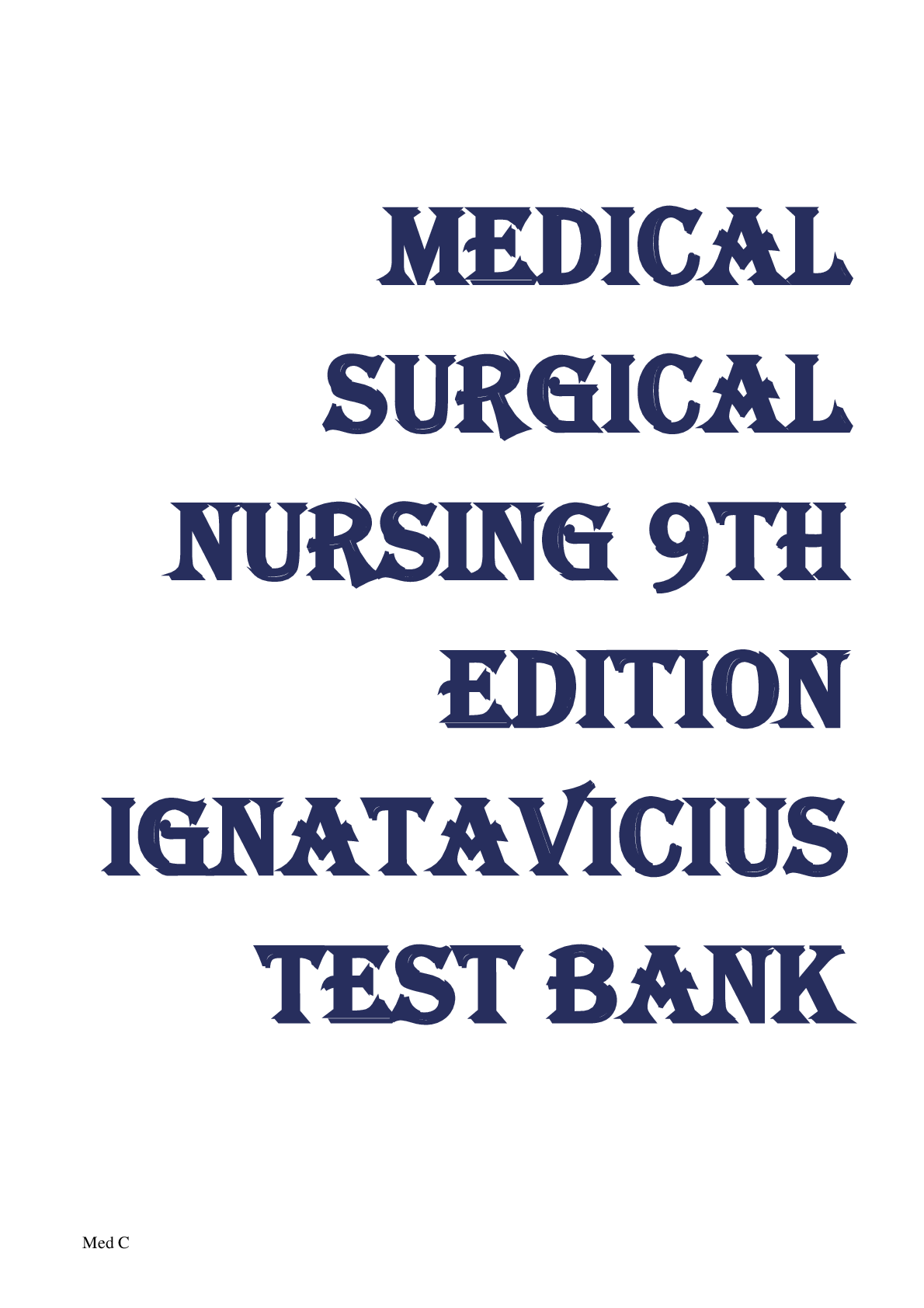

.png)
.png)
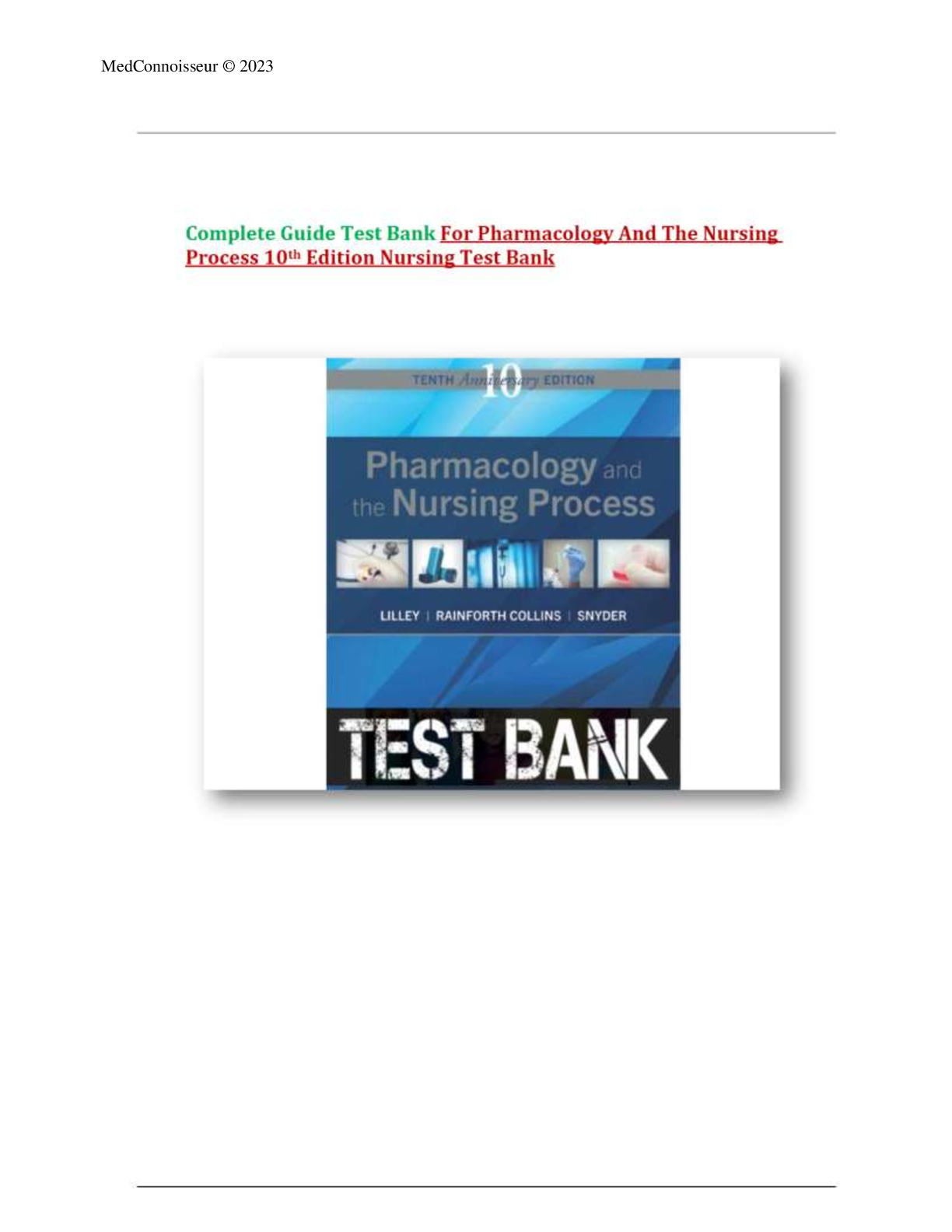

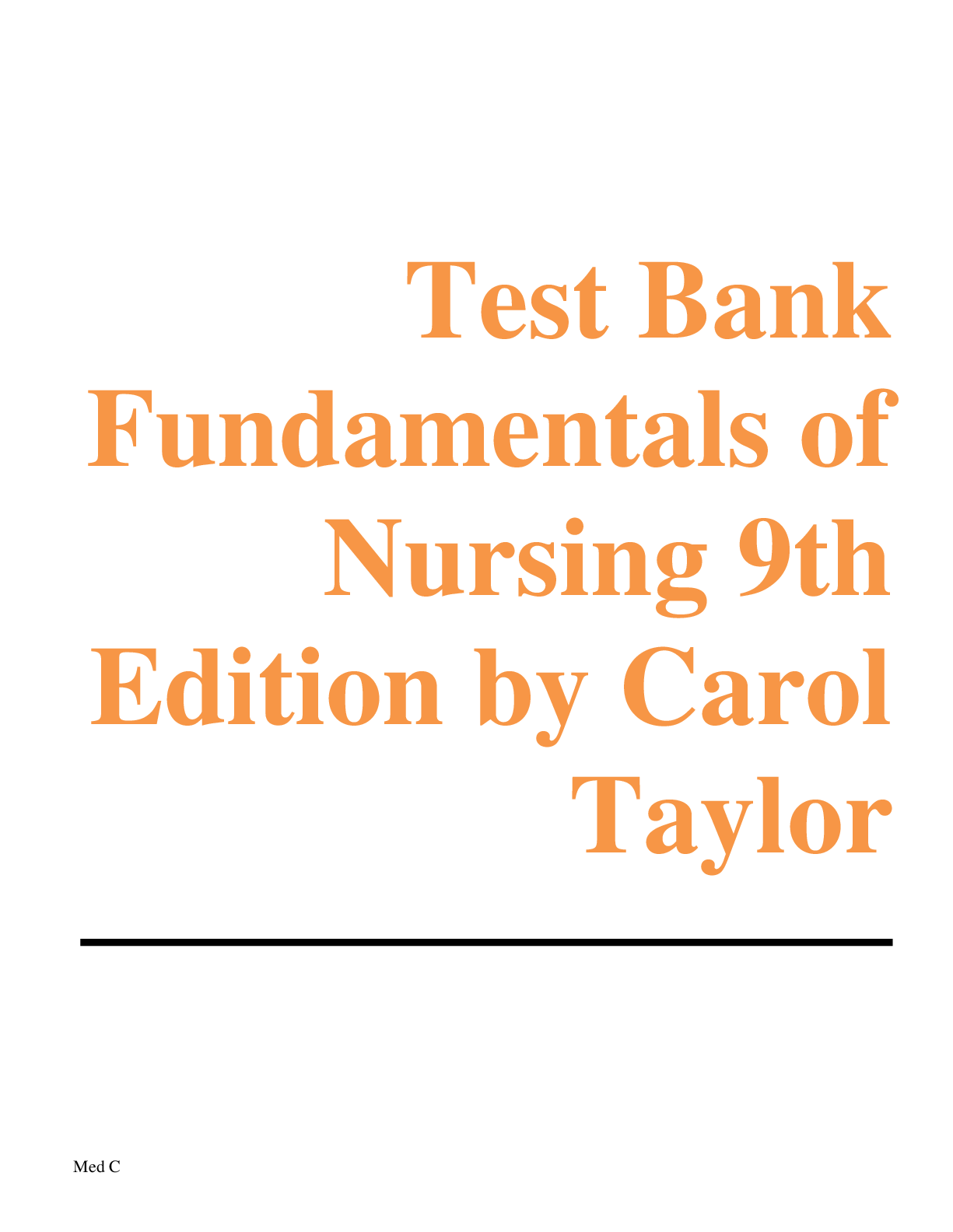

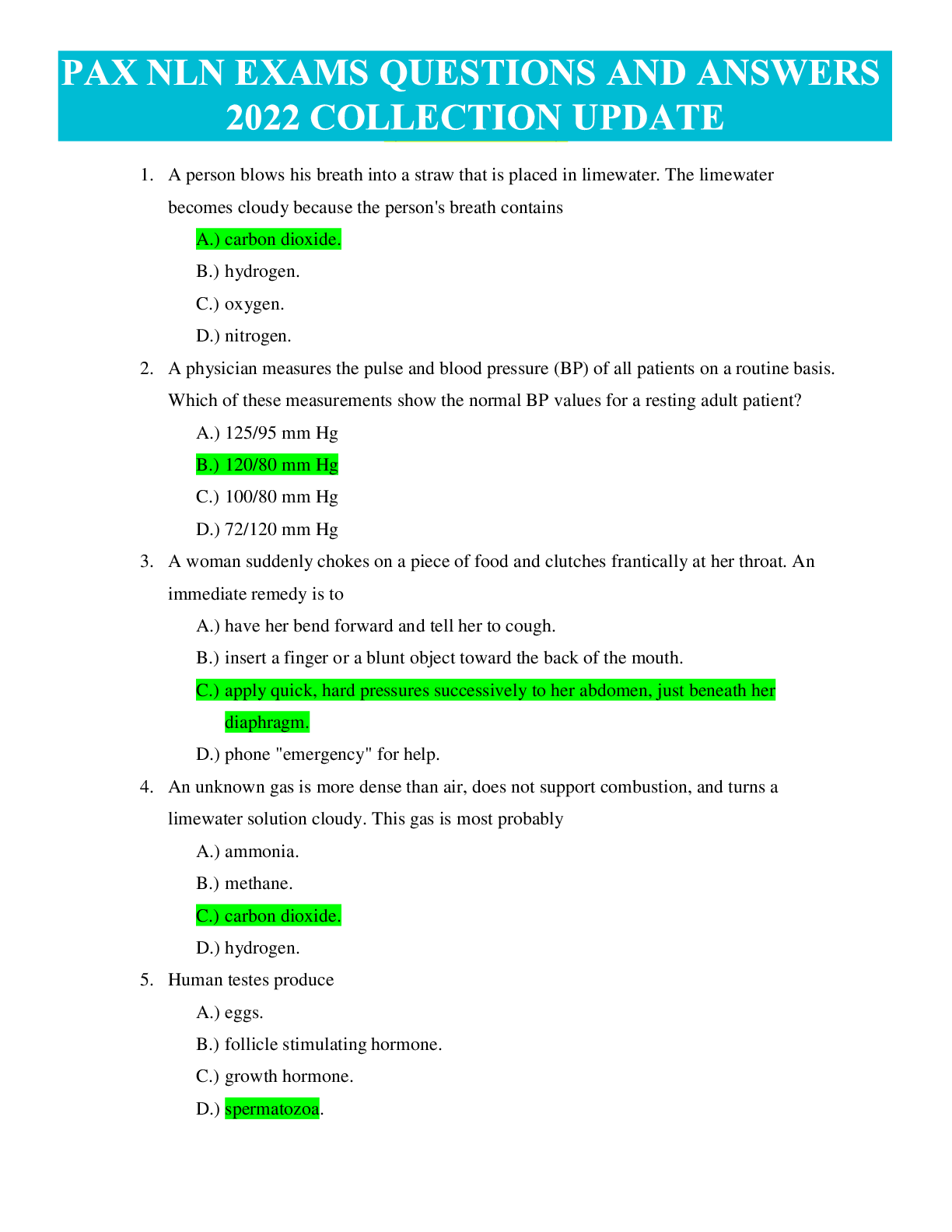

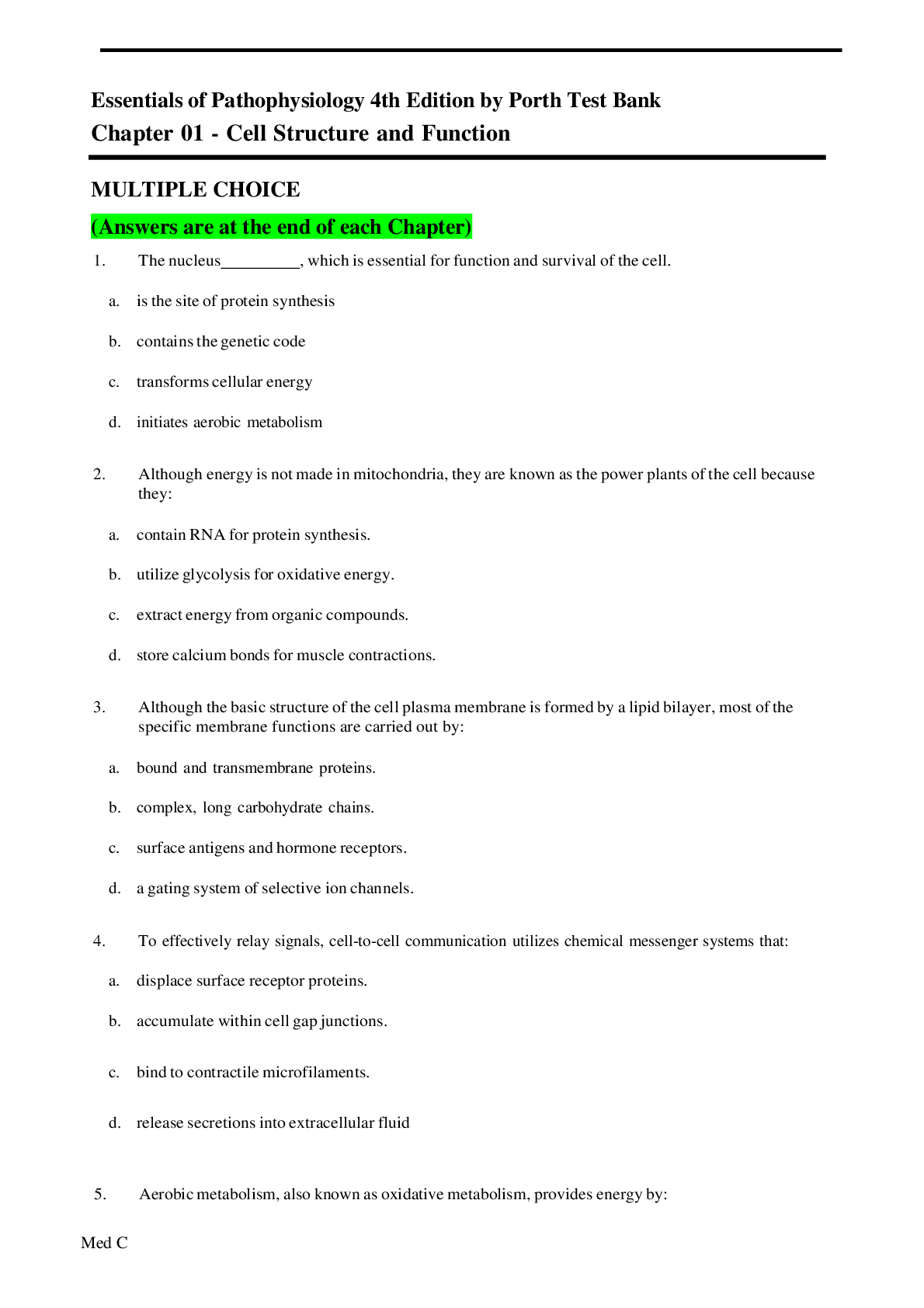

.png)



